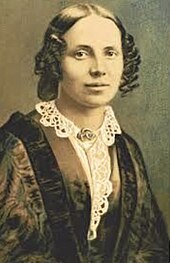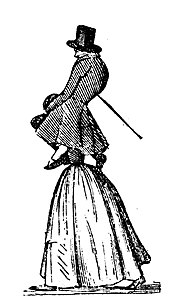Regine Olsen
Regine Schlegel born Olsen (born January 23, 1822 in Frederiksberg ; † March 18, 1904 Frederiksberg) was a Danish woman who went down in literary history through the complicated relationship of the Danish philosopher and theologian Søren Kierkegaard (1813–1855).
Early years
Regine Olsen grew up in a bourgeois family in Frederikstedt, a suburb of Copenhagen . Her father, Government Councilor Terkel Olsen, had his daughter instructed by the budding lawyer Frederik Schlegel. Decades later, he would become her husband.
In the spring of 1837, the fourteen-year-old Regine met Søren Kierkegaard, a theology student eleven years her senior, about whom Romano Guardini judged: seldom has a personality been more complicated than his . Despite the difference in age, the young people immediately felt drawn to one another and began a lively correspondence, almost all of which remained from Kierkegaard's letters. He began to influence her mind and soul, suggested to her which paragraphs in which books she should read. He found access to her family, who welcomed him benevolently. Shortly after Kierkegaard had passed his theological state examination at the University of Copenhagen in July 1840 , he became engaged to Regine on September 10th.
From his diaries (which, however, cannot always be trusted) and letters it emerges that days later he had doubts about the future course of their love. Doubt as to whether it was compatible with his religious determination and the sadness inherited from his father. And according to an undated letter to a friend, there were also doubts as to whether his love for Regine was sufficient for the continuation of a marriage: I cannot fully understand what impression she made on me. Because what is certain is that she almost surrendered to me adoringly, asked me to love her, it touched me to such an extent that I wanted to risk everything for her. However, how much I loved her, this also shows that I always wanted to hide from myself how much she actually touched me, which is actually not related to the erotic .
One month after the engagement, on October 11th, Kierkegaard sent his ring back and terminated the engagement. Regine Olsen was shocked, desperate, and asked Kierkegaard in vain to return to her. Concerned about the state of his daughter's soul, Terkel Olsen went to see the student and asked him, also in vain, to reverse the momentous decision. He offered Regine outwardly to portray the breach of the engagement that had got around in Copenhagen as if it had come from her. She refused. In diaries and letters, Kierkegaard noted that during this time he was deeply torn and desperate. Two months after the falling out, he left Copenhagen and went to Berlin for five months to study .
Disgusted
From 1843 on, Kierkegaard wrote books without interruption, a total of 55. Because of an inheritance from his late father, he could afford to publish them. This was often done under a pseudonym , but word of the author's real name quickly got around in Copenhagen, which had around 120,000 inhabitants at the time. And also that Regine Olsen had to be the model of the girl Cordelia in his writings. The little satirical newspaper Corsaren carried caricatures of him. Regine Olsen followed the work of Kierkegaard. And so she could read that, despite all his love, he dissected their relationship in detail, illuminated it from all sides and revealed intimate things to the public more or less veiled in literature.
She is called Cordelia in his works. Among other things, Cordelia describes his hero Johannes as follows: She was brought up strictly, for which I honor her parents in my grave; I could fall around my aunt's neck for it. She has not known the joys of the world, is not satiated with foolishness. She is proud, she defies everything that other girls enjoy, that's the way it should be. This is a contradiction that I will take advantage of. She does not like finery and splendor in the same way as other young girls; she's a little polemical, but a young girl as enthusiastic as she must be too. She lives in the world of fantasy. If it fell into the wrong hands, it could become something very unfeminine, precisely because there is so much femininity in it.
Or Johannes comments: No, only when you achieve that a young girl has only one task for her freedom, namely to surrender, that she feels all her bliss in it, that she almost implores this surrender and is still free - only then is it enjoyment, but this always includes spiritual influence.
Johan Frederik Schlegel
On November 3, 1847, Regine Olsen married her former teacher, the art-loving lawyer and senior administrative officer Johan Frederik Schlegel. According to reports, the marriage turned out to be happy. Søren Kierkegaard was stunned, indignant, he had assumed that, despite everything, she would remain loyal to him forever. From then on there was growing contempt for women in his works. Kierkegaard continued to try to analyze fleeting encounters with Regine on the street or in church, noted down every gesture, and at times hoped for a rapprochement. When he learned of her father's death in 1849, he sent Schlegel a letter asking him to hand it over to her. He sends it back unopened. In 1850 Frederik Schlegel was appointed governor of the Danish West Indies colony . Before the couple left, Kierkegaard saw Regine for the last time from a distance.
Kierkegaard was killed on November 11, 1855 after a stroke. The Schlegels returned to Copenhagen in 1860. Frederik Schlegel died in 1896. Regine Schlegel lived in Copenhagen until 1904. She gave information to scholars who wanted to know more about her relationship with Kierkegaard and approved the publication of his letters to them. It is not known whether she withheld letters.
annotation
Generations of scientists occupied themselves and are still occupied with Kierkegaard's works. They rate Kierkegaard primarily as one of the great philosophers and religious writers and largely agree that his works are unthinkable without Regine Olsen's influence. His relationship with her is judged very differently. It is named as one of the great love stories in world literature, as well as a story of religious self-doubt and even the accusation that it was a case of mental abuse.
literature
- Joakim Garff: Kierkegaard's Muse: The Mystery of Regine Olsen. Princeton University Press, 2017, ISBN 978-0-691-17176-0 . (engl.)
- Michael Bongardt : Freedom in bondage service - To Sören Kierkegaard's understanding of sin and redemption. In: Anja Middelbeck-Varwick (ed.): So sin lurks at the door (Gen 4.17) - thinking about the phenomenon of fallibility. Verlag Lang, Berlin 2011, ISBN 978-3-631-59858-0 .
- Sören Kierkegaard: Diary of the seducer . Translation: Gisela Perlet , epilogue: Elmar Krekeler. Manesse Verlag, Zurich 2013, ISBN 978-3-7175-2302-4 .
Individual evidence
- ↑ Love continues to surpass itself. In: Die ZEIT. No. 32, 1955. zeit.de
- ^ Peter P. Rohde: Søren Kierkegaard with self-testimonials and picture documents . Rowohlt Verlag, Reinbek 1988, ISBN 3-499-50028-0 , p. 54.
- ^ Søren Kierkegaard: Diary of the seducer. Manesse Verlag, Zurich 2013, p. 79.
- ^ Søren Kierkegaard: Diary of the seducer. Manesse Verlag, Zurich 2013, p. 82.
- ^ G. Kringelbach: Schlegel, Johan Frederik. In: Dansk Biografisk Lexikon. 1st edition. Volume XV, Copenhagen 1901, p. 173 f.
- ^ Peter P. Rohde: Kierkegaard. 1988, p. 105.
- ↑ Peter P. Rohde Kierkegaard. 1988, p. 169 ff.
- ↑ Elmar Krekeler afterword in: Sören Kierkegaard: Diary of the seducer. 2013, p. 311.
Web links
| personal data | |
|---|---|
| SURNAME | Olsen, Regine |
| ALTERNATIVE NAMES | Schlegel, Regine (married name) |
| BRIEF DESCRIPTION | Love from Sören Kierkegaard |
| DATE OF BIRTH | January 23, 1822 |
| PLACE OF BIRTH | Frederiksberg |
| DATE OF DEATH | March 18, 1904 |
| Place of death | Frederiksberg |



